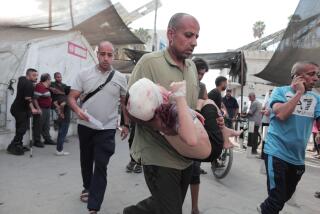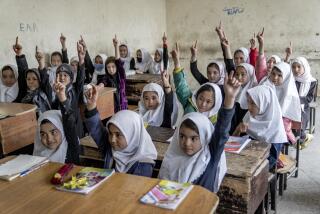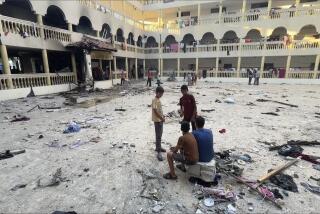In Pakistan, children attend school in shadow of fear after attack
- Share via
Reporting from PESHAWAR, Pakistan — Khaula Syed Ali remembers tucking her 8-year-old son’s white school uniform shirt into his beige shorts and combing his hair. But the boy was pleading.
“Mama, please don’t send me to school,” said Ahmed, who is in the second grade. “The Taliban will kill me.”
As Syed Ali tried to get the boy out the door last month in time for the 7:30 a.m. school bus, she knew he was not alone in his fear.
Weeks after a devastating Pakistani Taliban raid on a school in this northern city, which killed 133 children and 16 staff members, students in Peshawar and across the country remain tormented by fear. The Army Public School opened Monday for the first time since the Dec. 16 attack amid tighter security and fresh coils of barbed wire atop the compound walls.
After winter holidays that were extended as a safety measure, hundreds of other schools also resumed classes, some after installing new security cameras and higher boundary walls as ordered by government authorities struggling to cope with the militant threat.
“The children in the neighborhood discuss the Taliban all the time,” said Syed Ali, a schoolteacher, who recounted her son’s fears in the days after the attack. “This has frightened him more. I fear this conversation among children has steadily replaced what used to be games in their playtime.”
The raid underscored the vulnerability of Pakistan’s schools, which have long been a battleground for militants who view the country’s formal education system as inspired by the West and therefore un-Islamic. Attacks on more than 1,000 schools over the last eight years have sown fear among the population.
The assault on the education system has an added, and worrisome, impact, analysts say: The madrassas, or Islamic religious schools, that increasingly are replacing closed facilities have helped create a new generation of young men sympathetic to extremists.
Young pupils, especially in the country’s volatile northwest, have seen everything from bomb attacks to the burning down of school buildings and point-blank shootings of teachers and classmates — most famously the teenage student activist Malala Yousafzai, who survived an attempted assassination by Taliban militants in 2012 and was award the Nobel Peace Prize last year.
By some estimates, extremists have destroyed more than 1,000 schools, most of them in the northern tribal belt. Local groups say the number is significantly higher, but it is difficult to gather exact data because of militant activity.
“Where private schools used to spend money on playgrounds and field trips, schools administrations now grapple with the security demands of parents,” said Aslam Mehsud, a member of the teachers union in Peshawar. “We now spend that money on private guards.”
The attacks on schools began in 2007 and have accelerated in recent years. The Global Coalition to Protect Education from Attack said there were 838 to 919 militant assaults on Pakistani schools between 2009 and 2012, the most current figures available.
The schools are taken over by insurgents for use as hide-outs and transit camps, or by the army as outposts. Military raids on former schools have uncovered stocks of weapons and armor hidden by militants, according to officials in the tribal belt.
“These schools were destroyed by the Taliban at night and not during school hours,” said Adnan Khan, an education official in Khyber-Pakhtunkhwa province, of which Peshawar is the capital.
To many, that is what made the Peshawar assault even more devastating: The insurgents attacked during the day and targeted students, mainly boys 12 to 16, at a school where most of the pupils are the children of army officers.
Analysts say the Pakistani Taliban — a loose federation of extremist groups aiming to overthrow the elected government in Islamabad — has also benefited because many bombed-out public schools are replaced by madrassas.
Many say the madrassa system — by providing students with shelter and thrice-daily meals — has created a generation of young people who are sympathetic to the Pakistani Taliban. In hundreds of small towns in Punjab, Pakistan’s most populous province, thousands of young men graduate from the madrassa every year.
Javed Khan, a police officer in Peshawar, said “more than two-thirds” of militants arrested in violent attacks around the city were students of madrassas. The others are foreign militants, he said.
Irfan Muzaffar, a researcher who studies education reform, said the madrassas have separated children from their families. “There remains no meaningful contact between the parents and their sons after they are given into the care of madrassas,” he said.
English teachers or those who spoke out against the Islamization of schooling have been targeted across the country by the extremists or religious groups that support them.
The attacks “helped them inflict an immediate sense of terror on the people they wanted to rule,” said Sami ul Haq, a former principal in the Mohmand tribal agency whose school was bombed and destroyed in 2010.
Haq said his town’s mostly moderate residents at first resisted the insurgents’ ideology. But with each year, they became more hesitant to oppose them.
“Now no one wants to put their children at risk,” Haq said. “In fact most of [the parents] ended up sending them to madrassas.”
Nationwide, about 25 million children are not receiving an education either in formal schools or madrassas, with Pakistan ranking second in the world for the number of children out of school. Of the 700,000 children not attending school in Khyber-Pakhtunkhwa, 600,000 are girls.
The violence has prevented Malala, the world’s best known Pakistani education activist, from returning home more than two years after Taliban gunmen shot her because of her calls to keep girls’ schools operating. Despite army operations that officials claimed drove militants out of Swat, a picturesque valley in Khyber-Pakhtunkhwa where Malala lived, advocates of formal education for both girls and boys still face regular violence.
Broken windows, sandbags for chairs and classrooms without roofs are what the few remaining schools have to offer to children in the city of Mingora. After Malala was attacked, schoolteachers and children continued protests against the extremists and demanded that destroyed schools be rebuilt. Some families opened makeshift classrooms on public lawns and in private homes, but many closed after receiving threats.
Hakim Khan Mehmood, a teacher who started one such alternative school, said he received letters for months warning, “Stop your activities or we will kill you.”
Another teacher who supported Malala was stoned; plans to name a school after the girl were scrapped after warnings from ultraconservative religious groups.
“The military may claim they have had an operation in Swat, but the Taliban and other militants still live in the streets of Mingora,” said Qari Abdul Samad, a moderate cleric in the southern city of Karachi. “They shop in the markets, and they threaten people under the nose of the Pakistani army.”
Samad, originally from Swat, has been beaten and shot at and has moved multiple times. Even in relatively cosmopolitan Karachi, he said, right-wing religious groups challenge him for urging people to not support extremists.
“My children and my family have been threatened,” he said. “It’s impossible to counter the political manipulation of the jihad ideology in Pakistan. And it all originates from how people are educated in this country.”
Nazish is a special correspondent.
More to Read
Sign up for Essential California
The most important California stories and recommendations in your inbox every morning.
You may occasionally receive promotional content from the Los Angeles Times.










